Lovesick swains praying for either consummation or forgetfulness, maidens lamenting their lovers’ absences, men excoriating their faithless mistresses, women attacking men like bacchantes on a rampage, nymphs and shepherds, captive creatures, fever and repose, solitude and tender companionship. You might imagine that’s rather a lot to put into a dance, but Douglas Dunn expresses all that and more in his fantastically beautiful Cassations.
Dunn is one of the most imaginative, distinctive, and occasionally eccentric choreographers I can think of. In this new venture, he has some famous dead collaborators—Bach, Mozart, Scarlatti, Handel, Donizetti, Bellini, Fauré, Debussy. Some of the recordings are old and scratchy, but it’s miraculous how, for example, tenor John McCormack’s 1920 rendition of Handel’s “Sleep” from the opera Semele slides into Renée Fleming’s contemporary one of the gorgeous “Ombra Mai Fu” from the composer’s Serse (an aria sung earlier in Cassations by Cecilia Bartoli—amber honey to Fleming’s golden). Although Dunn’s visions vis-a-vis the lustrous compositions that he chose may be startling, they never violate the music’s ambiance.
He has reconfigured the seating in the 92nd Street YM-YWHA’s high-ceilinged Buttenwieser Hall to surround the wooden floor on all four sides. There isn’t much equipment for lighting wizard Carol Mullins to work with, and the spectators—some seated very close to the performing areas—are rarely in the dark. Mimi Gross has created several outsized painted plants—a huge tiger lily for instance—that the performers cart away before the piece begins and bring back for the last section.
The décor is in keeping with the Cassation’s title, which, in turn, is drawn from the music that accompanies the opening dance: Mozart’s Cassation in G Major, K. 63. A cassation is an 18th-century suite intended for outdoor performance. It’s a good thing, then, that the dancers wear yellow rain ponchos to cart away the foliage—not just to indicate that this garden diversion has been moved inside, but the better to stun us with their attire when they reenter to dance. Gross’s vivid, multi-colored costumes evoke commedia dell’arte craziness in a decidedly contemporary way, and over the course of Cassations, the twelve dancers add (or remove) skirts, embroidered vests, filmy tops, and other articles of clothing to their short or long tights and sleeveless tee shirts with different-colored trim.
The garden images may also relate to Dunn’s decision to use “Ombra Mai Fu” not once but twice. I’ve never quite figured out why the hero of Handel’s love-mixups-galore opera seria sings the opening aria to his beloved plane tree, but no matter; the composer gave us a ravishing, melody (also known as “Handel’s Largo” and included in collections for piano students).
Much of the dancing in Cassations is done by four men (Miguel Anaya, Paul Singh, Timothy Emmett Lee Ward, and Christopher Williams) and five women (Kira Blazek, Liz Filbrun, Gabriella Hiatt, Emily Pope-Blackman, and Jin Ju Song-Begin)—all of them gifted and wonderfully individual. They’re joined at times by dancers of another generation: Grazia Della-Terza and Gwyneth Jones and (more often) by Dunn himself.
Dunn has designed the choreography for multiple fronts—often creating circles within perimeter squares. To “Calm My Soul” from Handel’s Alexander Balus, all five men punch the air and point wildly in different directions, and after the women have slowly attacked them with telling little stings, the men recline on the periphery while the women cluster serenely, taking turns at being in the center of their little circle.
Dunn’s career as a dancer in Merce Cunningham’s company (1969-73) may have contributed to his interest in what legs can do, as well as to his skill in making them be speedy and articulate when desired. The dancers in Cassation skitter and stamp and scamper and mince on tiptoe; they use their legs like knives, kick high, leap with finesse. But their hands are busy too, shaking stiffly in clench-fisted wrath, trembling, caressing the air a couple of inches above a reclining partner’s hip. Dunn has not only engineered the choreography so that spectators on every one of the room’s four sides have equally fine views; he has constructed many movements that emphasize three-dimensionality. The performers twist and bend and shiver and reel as they respond to the music’s flow or the tenor of a song’s lyrics. And, since many of the accompanying words deal with lost love or unattainable love or separation from a beloved, the men and women of this world scan a distant horizon searchingly, or raise their eyes toward an apparently unhelpful heaven.
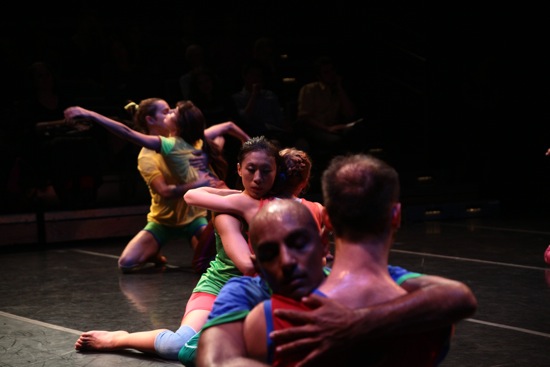
Front to back: Christopher Williams, Paul Singh, Emily Pope-Blackman, Jin Ju Song-Begin, Kira Blazek, Timothy Emmett Lee Ward. Photo: Jules Bakshi
These are very expressive performers. Without fakey acting, they convey their moods and their interest in one another. Here, just to my right, is Anaya in a state of passionate imbalance. Over there is Blazek, fixing a man with a fierce stare. Close to me, Ward struggles with Anaya, projecting an almost flirtatious pleasure in the game, while in the distance, Williams splits his legs as Singh thrusts him high in the air (this quartet to Glen Gould’s recording of a Bach Two-Part Invention). Close to the end of Cassations, four pairs (two of them same sex) spend much of Debussy’s Nuages on the floor, quietly investigating tender connections; Pope-Blackman and Anaya are very near me, and I can see them thinking, feeling.
Those feelings are also built into the choreography. No “acting” is needed when Song-Begin escorts Hyatt around the border of the area, holding her closely, cheek to cheek (across the room, Blazek and Filbrun make a similar sisterly trek). Dunn, dancing alone to a scratchy recording of Caruso singing “Core ‘ngrato” by Salvatore Cordillo and Ricardo Cordiferro, eloquently reflects by his unsteadiness and questing turns in new directions the dual aspects of a plaint addressed to a cruel mistress and to God.
Some of the 15 dances in the two-part presentation are disturbing, boisterous and/or comical, and small jokes abound (the men hurry away, bent over, clutching their crotches, as Guiseppe di Stefano finishes singling “Quanto e bella” from Donizetti’ L’elisir d’amore). To Bartoli’s rendition of “Ombra ma fu,” Dunn enters in a preposterous get-up— a decorated, long, transparent, green plastic coat over his lime-green Bermuda shorts and a headdress that evokes in some very weird way the à-la-Turque element in 18th-century opera. His partner is no silent tree, nor is Dunn’s loving. He’s holding a long cord, at the end of which is Williams, girdled by the kind of equipment that aerial performers use so they can turn. Pulling against the restraint Williams (marvelously creaturely), performs all sorts of nimble moves, eyeing his “trainer” contentiously, but once Dunn cracks the whip he’s carrying, his captive is more cautious. Once they come very close, face to face, but quickly resume their roles. It’s interestingly ironic that in the following episode for five women, the song, “Amara Servitù” (from Francesco Cavalli’s Muzio scevola, sung by Glenda Simpson), speaks of “painful servitude” from a different perspective.
When Scarlatti’s martial Sonata in E major, K380 (played by Maggie Cole) rings out, all seven women drill, flourishing big, artfully designed fake weapons of all sorts, and go after the men. As the music ends, and the lights dim out, someone is slashing a guy’s throat with a machete. But when the music changes to an impassioned flamenco soleares, “No me quiere tu gente,” sung by Terremoto de Jerez (with accompanying guitar, hand claps, and approving yells), four men go on the offensive, sharing two long poles which they whip around and use to temporarily barricade the women or battle them. The macho warriors, however, also lie supine, holding those big sticks insinuatingly erect for the women’s inspection (and worse).
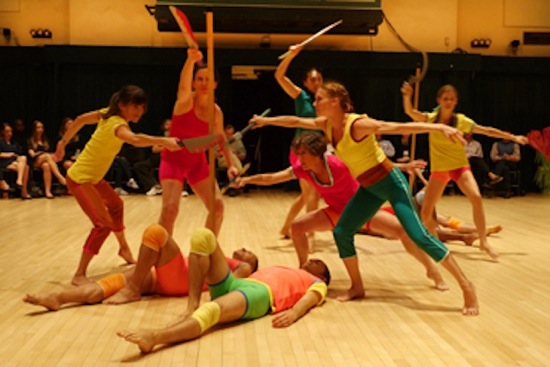
Women warriors, endangered men (L. foreground: Kira Blazak; R. Emily Pope-Blackman). Photo: Jacob Burhardt
An ancient Bulgarian song, “Mari Stanko,” sung by Ellen Santaniello, alternates between raucous passages and lyrical ones, and the dancers go terrifically wild when the voice and instruments do, but Cassations as a whole ends on a tranquil note. Netania Davrath sings “Baïlèro,” one of Joseph Canteloube’s Songs of the Auvergne, and three of Gross’s big flowers return to the stage. So do all twelve performers. In this garden, I can even postulate that the performers are improvising—at least in part—so diverse and seemingly spontaneous their serene actions and interactions. The sun has come out, and the party concludes in virtual open air, while the singer calls out to the shepherd across the river to join her on the lush green grass. Where we’ve been all along.

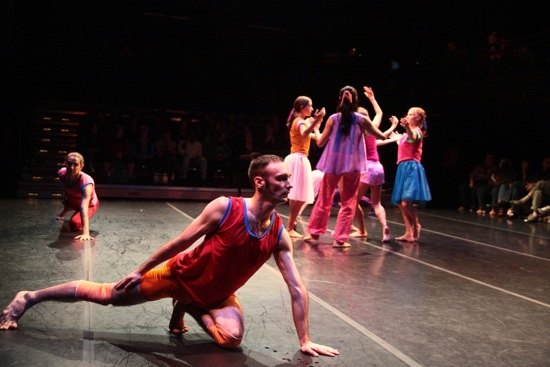
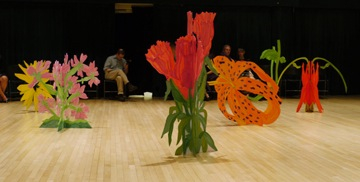
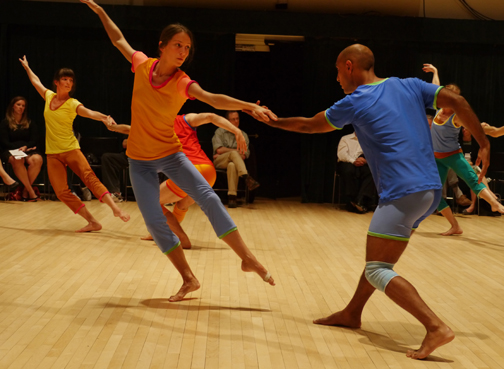
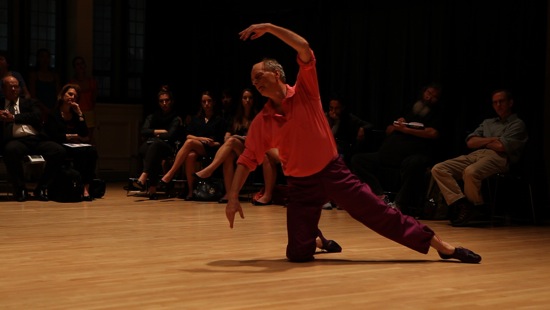
Sounds like a swell performance, and what heavenly music Mr. Dunn chose. Thanks Deborah for your customary vivid description and informed assessment. I wonder if the crotch-clutching is a commentary on the crotch grabbing moves of some contemporary Hip-Hop artists. Rennie Harris’s company comes to mind.
I’ve been receiving email alerts on these posts from a Gmail address for one Doug McLennan and thinking, “These sure are good. Who’s this McLennan guy and how did I discover his dance writing?” Having followed the link back to the original post this time, I realize why the writing strikes me as knowledgeable, assured, sensitive, evocative, and more: it’s Deborah Jowitt, whom I’ve known of and admired since at least the 80s. We should all be glad she’s still got a forum.
Thank you, Ms. Jowitt, for this post and all the others.
I was tickled (and flattered) by your comment, John Branch. Thank you. I enjoy your imagining that Arts Journal’s intrepid editor Doug McLennan had written my reviews. And, of course, I’m grateful to him for sending you alerts. You’re not the first person to find the author’s name hard to locate on an individual post.